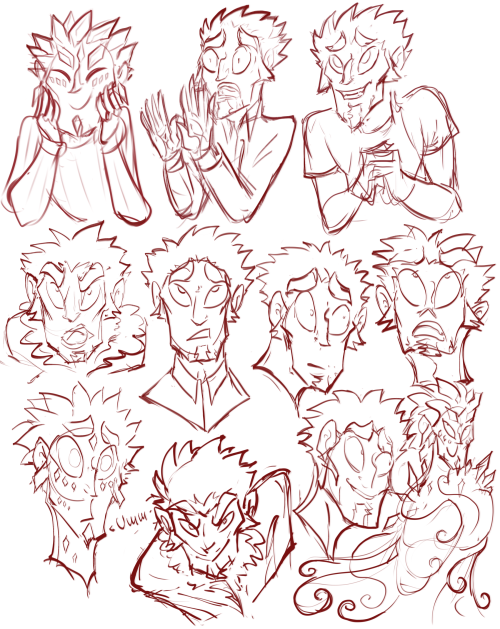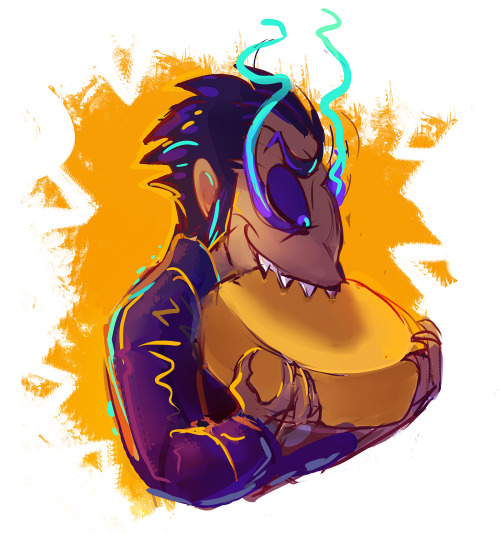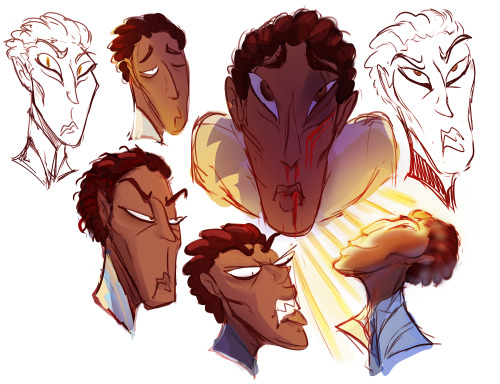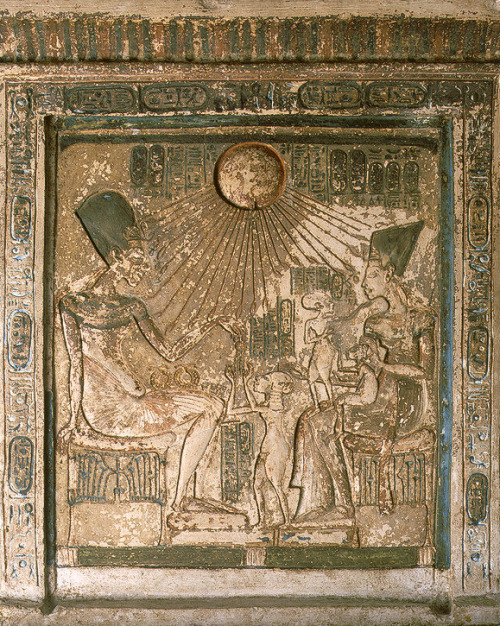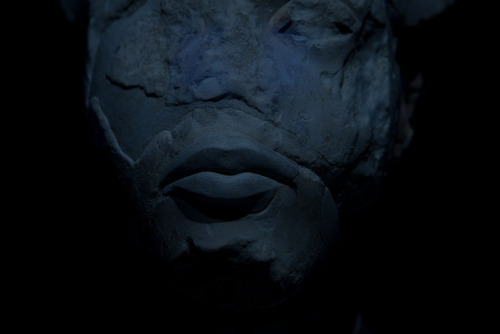#akhenaten





~ Face of Akhenaten.
Culture: Egyptian
Period: New Kingdom; 18th dynasty, period of Akhenaten
Date: 1372-1355 B.C.
Place of origin: Amarna, Egypt
boundary stela of king akhenaten’s capital city akhetaten, modern day tel el-amarna, egypt.
Post link
Mummy of Queen Tiye, the mother of Akhenaten and grandmother of Tutankhamun now in the Egyptian Museum.
~Hasmonean
Post link
TORRENT - Barbed Wire Strangulation
Akhenaten,from the temple of Aton in Karnak, Egypt. 1353 - 1335 BCE. New Kingdom.
- 13’ high. made of sandstone.
- originally named Amenhotep IV; name change represents a significant change, especially religious. he is changing his family name, distancing himself.
- abandoned polytheism in favor of Aton from Amen-Re.
- henotheism - belief that one god is superior to other gods
- moves capital from Thebes down the river to Amarna
- declared himself son of the sun and sole prophet of Aton. develops an entire cult.
- Aton represented by the sun disc, unusual because most gods in egypt were represented anthropomorphically.
- after akhenaten died, the egyptians returned to old tradition
- effeminate features; very curvy, almost hourglass figure. doesn’t have a perfect stomach and the costume promotes it. arms aren’t muscular; very thin. exaggerated and stylized: lips are larger, nose longer, eyes take up a large portion of the head. elongated figure, looks weak.
- truly revolutionary. he decided to move away from canon with the change of religion. no gender was assigned to a sun disc/Aton; the androgyny of the sculpture reflects Aton’s sexlessness.
- the premise of Aton’s cult was truth; theory that Akhenaten portrayed himself this way because of this.
- by the time we get to Akhenaten, there’s been a lot of genetic inbreeding. results in illness and deformity. lends to why he looks so different, asymmetry of the features, elongated, larger head.
Post link
King Akhenaten offering an olive branch to the Aten
New Kingdom, 18th Dynasty, Amarna Period, Egypt, c. 1345 B.C.
Post link

New evidence from Akhenaten’s capital suggests that a ‘disposable’ workforce of children and teenagers provided much of the labour for the city’s construction
There’s a whiff of magic about the site of Tell el-Amarna that makes the hair on the back of my neck stand on end. It’s partly down to the effort of imagination needed to conjure a great capital of ancient Egypt from the sea of low humps stretching between the cultivation and the desert cliffs, and partly the long shadows cast by its founders – the ‘heretic’ pharaoh Akhenaten and his queen Nefertiti.
Amarna came and went in an archaeological moment. It rose and fell with Akhenaten and his religious reformation, under which Egypt’s ancient pantheon of gods was briefly usurped by the worship of a single solar deity; the Aten.
On an uninhabited stretch of the Nile’s east bank, Amarna was founded, constructed and abandoned in under fifteen years. When Akhenaten died in 1332 BC, Egypt’s ancient religion was restored under his successor Tutankhamun and the heretical city of Amarna was flattened and forgotten.
Recent research at the site has focused on Amarna’s cemeteries; not the flashy rock-cut tombs of the royal family and its courtiers, but the simple desert graves of the ordinary Egyptians who lived and worked in Akhenaten’s city and never got to leave.
Sign up for Lab notes - the Guardian’s weekly science update
Read more
Between 2006 and 2013 I was lucky enough to work for the Amarna Project on an excavation which aimed to recover four hundred individuals from a large cemetery behind the South Tombs cliffs, estimated to contain around six thousand badly looted burials. The study of these burials and their human remains has opened a new research window on life and death in the lower echelons of Egyptian society. They paint a picture of poverty, hard work, poor diet, ill-health, frequent injury and relatively early death.
In other respects the South Tombs Cemetery remains were fairly in line with expectations. There were modest variations in the wealth and style of burial, there was a fairly even mix of male to female individuals, and the age distribution showed the usual pattern for ancient populations; high infant mortality giving way to fewer deaths as children survive into early adulthood, with the death rate then rising again as adults succumb to illness, childbirth, injuries and age. This was all important and highly interesting, but not particularly unusual.

The North Tombs Cemetery
In 2015 we began excavating another non-elite cemetery in a wadi behind a further set of courtiers’ tombs at the northern end of the city, and here the tale takes a stranger turn. As we started to get the first skeletons out of the ground it was immediately clear that the burials were even simpler than at the South Tombs Cemetery, with almost no grave goods provided for the dead and only rough matting used to wrap the bodies.
As the season progressed, an even weirder trend started to become clear to the excavators. Almost all the skeletons we exhumed were immature; children, teenagers and young adults, but we weren’t really finding any infants or older adults. Our three excavation areas were far apart, spaced across the length of the cemetery, but comparing notes all three areas were giving the same result. This certainly was unusual and not a little bit creepy.
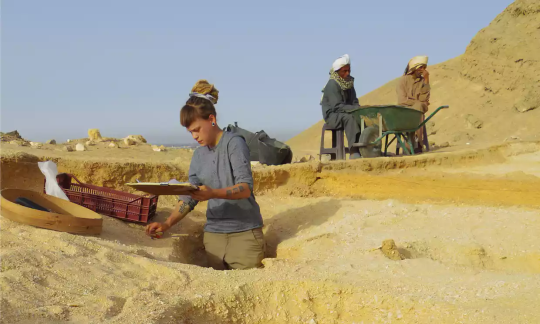
The initial skeletal analysis of 105 individuals excavated at the North Tombs Cemetery in 2015 has now been completed by Dr Gretchen Dabbs of Southern Illinois University, and it seems our initial impressions were absolutely right. More than 90% of the skeletons have an estimated age of between seven and twenty-five years, with the majority of these estimated to be younger than fifteen. Essentially, this is a burial place for adolescents.
This leaves us with some explaining to do. Seven to twenty-five is the age range in which people shouldn’t be dying; this is when health should be most robust in a normal population, yet for the people of the North Tombs Cemetery death seems to have come almost exclusively during these years. On the other hand, young infants, which usually abound in ancient cemeteries, are virtually absent with just three of the 105 skeletons estimated to be under seven years old. The North Tombs Cemetery shows the exact opposite of the usual demographic pattern for a cemetery.
The skeletal pathologies at the North Tombs Cemetery also had some curious features. For such a young population, traumatic injuries and degenerative conditions were very common. The majority of 15-25 year-olds had some kind of traumatic injury and around ten percent had developed osteoarthritis. Even in the under 15s, sixteen percent were found to have spinal fractures along with a range of other abnormalities usually associated with heavy workloads.
The most obvious explanation is not a pleasant one: This population seems to have been a workforce of children and teenagers who had to perform frequent heavy labour. Seven years old is about the earliest age that children might be expected to carry a load and follow instructions, hence the absence of younger skeletons. The absence of older adults suggests two possibilities; either workers were released or re-assigned when they reached full adulthood, or the nature of the work and living conditions meant that none of the workers lived much past twenty-five. Indeed, it seems they were lucky to make it to fifteen.
The isolation of these young people in death raises questions about how they lived. Family was very important in ancient Egypt and it was the responsibility of relatives to see that dead family members were properly provided for in the afterlife. The fact that the North Tombs Cemetery dead were buried with little care and virtually no grave goods strongly suggests that they were not returned to their families for burial but lived and died away from the care of relatives.
A further indication of the grimness of life for the young people of the North Tombs Cemetery comes from the multiple burials. 43% of graves contained more than one individual, which is way higher than the small proportion of multiple graves at the other Amarna cemeteries.
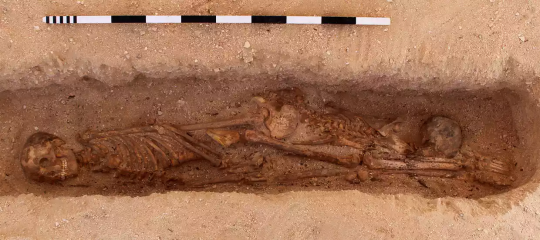
At the North Tombs Cemetery the multiple burials, sometimes holding as many as five or six skeletons, contain children of such similar ages that family relationship seems unlikely, while at the South Tombs Cemetery multiple burials appear to represent family groups. South Tombs multiple burials are laid side by side in graves dug to double or triple the usual width, but at the North Tombs Cemetery graves containing more than one skeleton are about the same size as the single burials with the bodies stacked directly on top of each other.
The implication of the North Tombs multiple burials may be that bodies were expected and a grave was dug at the cemetery without knowing how many bodies there would be. Sometimes there was just one body, but if more were delivered the same grave would do for all of them. Whether this collection of casualties was a daily, weekly or monthly occurrence is a matter for bleak speculation, but the cemetery is large, probably containing at least a couple of thousand burials.
Who is buried at the North Tombs Cemetery?
This is a difficult question at this early stage of the project and all our current theories have their drawbacks. The North Tombs Cemetery lies towards the main stone quarries and it seems most likely that these people were employed somewhere in the quarrying process as unskilled labour during the frantic construction of the new city.
One possibility is that these are Egyptian children, perhaps demanded from their families as a contribution to the construction of the new city, or singled out in some other way. Corvée-style labour, enforced and unpaid, was frequently used in ancient Egypt on major projects. It is also possible that these were the children of slaves and therefore viewed as more or less disposable. In either case, children seem to have been removed from their families with little intention of them being returned.

A further suggestion is that the North Tombs Cemetery may represent a captured or deported population brought to Amarna for labour. This is perfectly possible and would account for the lack of family contact and the apparent disregard shown for young life. On the other hand, there are no indications from the method of burial, the pottery and the few objects recovered to suggest that these people were not Egyptians.
We hope that future DNA analysis of the bones might clarify the geographical origins of the North Tombs Cemetery skeletons.
In any case, the evidence of the North Tombs Cemetery forces us to face the possibility that Akhenaten built his city at least partly with child labour.
For archaeologists, Amarna is both a blessing and a curse for understanding life in New Kingdom Egypt. On the one hand it provides a snap shot of a city of this period, conceived and built from scratch and not altered in later periods. On the other hand, Amarna is awkwardly exceptional in that it was built at great speed under an eccentric pharaoh and his strange new theology, so how representative might it really be?
If the building of Amarna employed child labour, could it have been a more widespread practice for state building projects in New Kingdom Egypt? At present comparable data from other Egyptian sites is very limited. The exceptional nature of Amarna makes it hard to extrapolate these findings from one highly unusual cemetery.
However, Egypt is littered with building projects of extraordinary scale by ancient standards, from pyramids and temples to canals and artificial lakes, commissioned by pharaohs with a similarly megalomaniac mind-set to Akhenaten. Perhaps when we marvel at these wonders of ancient engineering we should spare more thought for the price paid in human lives, some of them only just beginning, which constituted the cost of such high ambitions. Archaeologygives us the means to provide a counter narrative to the pharaonic bombast of the textual records and tell a grimmer tale of hard work and short lives.
All work at Amarna is carried out with the kind permission and support of the Egyptian Ministry of Antiquities. The work at the North Tombs Cemetery is supported with funding from the National Endowment of the Humanities. The Amarna Project is a project of the McDonald Institute for Archaeological Research, University of Cambridge.
Hello everyone, just a little update - we’re still working on Book 2, though it will be a few months before we can start posting it (hopefully in June). We’re also currently writing a side story from Ahriman’s perspective that we always intended to be a part of Book 2 experience. So keep fingers crossed for us, and once in a while we’ll be popping in here like this with some art ;>
If you’re just seeing our posts for the first time ever, these characters are related to our City and the Beast series books. You can read Book 1 for absolutely free at sharadrass.com or on AO3 (if you do, please please tell us :3)Or if you’d like to start with something shorter, you can readHigh Priests of America on AO3>>, a story about an old tired god who meets a stabby servant of the competition from across the seas.
Post link
Bust of Queen Nefertiti, discovered in Amarna, Egypt, made by Thutmose
“The Nefertiti Bust is a 3,300-year-old painted limestone bust of Nefertiti, the Great Royal Wife of the Egyptian Pharaoh Akhenaten, and one of the most copied works of ancient Egypt. Owing to the work, Nefertiti has become one of the most famous women of the ancient world, and an icon of feminine beauty.” (Source)
Post link
Queen Tiye’s head with a feathered crown from the Amarna Period (18th dynasty), yew wood, lapis lazuli, silver, gold and faience, ca. 1355 B.C, Egypt.
Tiye was the spouse of Amenhotep III, mother of Akhenaten and grandmother of Tutankhamun. She is represented with great realism and we can see her very distinctive features in the typical Amarnian style.
This head has had two different hairstyles over time and they have been modified for unknown reasons. The original one was probably a khat,which was a head cloth worn by the nobility. We can still see traces of its ornaments on Tiye’s forehead where the golden uraeus were attached. The khat let the ears bare and that’s why the queen is depicted wearing golden earrings. Interestingly, the khat was actually reserved to goddesses: Tiye and Nefertiti are the only mortals to have ever been represented wearing one.
The second hairstyle is the one we can still see today. For unknown reasons the first hairstyle was destroyed and its remnants were covered by a linen wig that hid the earrings.
This head was probably meant to be attached to a body that has not been discovered.
Photo by Steven Zucker / Courtesy of the Egyptian Museum of Berlin
Post link
Painted limestone stela, ca. 1353-1336 BC, El-Amarna, Egypt.
This limestone stela shows King Akhenaten and his family as a “Holy Family.” It is considered to be an icon and was intended to be kept in a private chapel of an Amarna house. The stela, topped by the cavetto cornice, is decorated with a scene of an intimate moment from the daily life of the royal family under the protection of Aten. - globalegyptianmuseum.org
Post link








